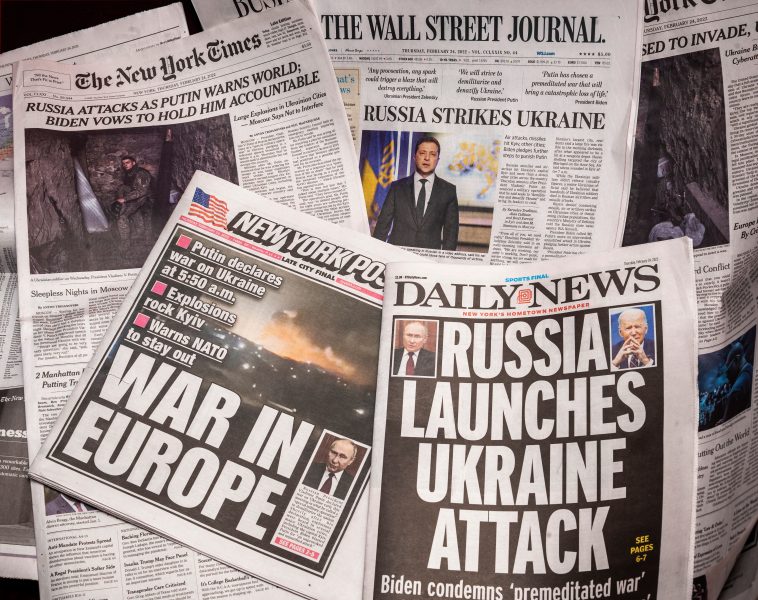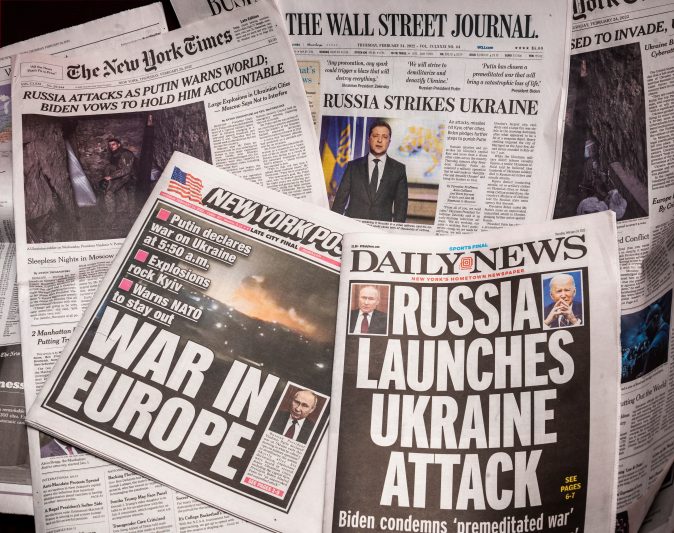By Olga Chaiko, Ukrainian journalist with the “Fakty” news programme, ICTV, SLM News
The war began at 4am on 24 February 2022. Soon after, a coalition of five major broadcasters called TV Marathon “United News” was formed to pool resources to cover the war. Two years later, with the war still raging, questions are being asked about the impact of it on media production in Ukraine.
The United News Marathon, a creature of war

At the start of the war, Ukrainians were glued to their screens, believing most of the information that came from the TV marathon. But this has changed. In December 2023, a survey conducted by the Ilko Kucheriv Foundation revealed that almost a third of Ukrainians think that the TV marathon had lost its relevance.
The Marathon was created in response to a provision of the military law that allowed the Ukrainian government to use private channels to inform the population about the conflict and the army’s progress.
Five TV channels united to produce 24/7 news about the war: three media holdings ‘1+1 Media’, ‘Starlight Media’ and ‘Inter Media Group’, as well as the public television and ‘Rada channel’, which covers parliamentary activities.
Not all Ukrainian media were invited. ‘5 Kanal’ and ‘Priamyi’, which are linked to the former President Petro Poroshenko, and the opposition channel ‘Espreso TV’ are not part of the News Marathon.
The network broadcasts without advertising. The three private media initially operated on their own budget. They now receive government funding.
Important and sometimes life-saving information
Under these conditions, there are accusations that the marathon is a source of propaganda. However, the media participating in the marathon work with the same journalists and say they follow their own editorial guidelines.
Each company has a six-hour slot. Live studios are available for them to organise interviews with military and government representatives, but also with volunteers providing essential daily information such as on evacuation procedures, battlefield updates, perspectives and analysis, and exchange of messages to those in captivity, as well as social and economic issues.
Despite current criticism, Marathon TV production has proved to be crucial and at times lifesaving.
At the beginning of the war, many journalists worked without adequate protections, we didn’t have body armour or helmets, and we worked around the clock. We lived in the newsroom and slept either in the office, or in shelters.
Public transport did not work for several months. There was no fuel for the vehicles, so the best way to be at work on time was not to leave it at all.
Our first stories were mainly done with our telephones. People in the streets were afraid to speak to us. They thought we might work as Russian spies, gathering information for the enemy.
Some journalists had to stop reporting as they focused on their family’s safety. Some of my colleagues joined the army as volunteers without any experience.
Getting together at the start of the war was therefore a very important move. It helped journalists to keep united, to counter Russian disinformation and to give journalists the strength and additional resources to carry on.
War reporting and how it has changed us
War has dramatically changed the way we live and work. We no longer cover the political battles, as political life is suspended during wartime, and we no longer have news of glamorous or entertaining events. Our main advertisements are announcements to raise money to buy drones or some other kind of aid for the army.
If the public interest of the participating TV stations in the news marathon was paramount in the beginning, it is different today but the majority of journalists expect this state-controlled media model to change once the war ends.

